Elementary Education (Grades K–6)
Subtest 2 Sample Items
Recommendation for individuals using a screenreader: please set your punctuation settings to "most."
Expand All | Collapse All
Question 1
1. Use the table below to answer the question that follows.
|
Item
|
Price
|
Discount
|
| Book |
7.55 |
25% |
| DVD |
15.29 |
10% |
| Calendar |
11.99 |
25% |
| Greeting card |
2.75 |
33% |
The table shows the discount on selected items in a bookstore. A customer wants to purchase a book, 2 DVDs, a calendar, and 3 greeting cards. Which of the following expressions is the best estimate of the total cost of the purchase?
-
 (8) +
(8) +
 (2)(16) +
(2)(16) +
 (12) +
(12) +
 (3)(3)
(3)(3)
-
 (7) +
(7) +
 (2)(15) +
(2)(15) +
 (12) +
(12) +
 (3)(2)
(3)(2)
-
 (8) +
(8) +
 (2)(15) +
(2)(15) +
 (12) +
(12) +
 (3)(3)
(3)(3)
-
 (7) +
(7) +
 (2)(15) +
(2)(15) +
 (12) +
(12) +
 (3)(2)
(3)(2)
- 1 fourth times 8 plus 1 tenth times 2 times 16 plus 1 fourth times 12 plus 1 third times 3 times 3
- 1 fourth times 7 plus 1 tenth times 2 times 15 plus 1 fourth times 12 plus 1 third times 3 times 2
- 3 fourths times 8 plus 9 tenths times 2 times 15 plus 3 fourths times 12 plus 2 thirds times 3 times 3
- 3 fourths times 7 plus 9 tenths times 2 times 15 plus 3 fourths times 12 plus 2 thirds times 3 times 2
Answer to question 1
- Answer Enter to expand or collapse answer. Answer expanded
- Correct Response: C. (Objective 0010) When estimating to solve this problem, start by rounding off the prices, and then use the discount to find the purchase price of each item. Each percent discount that is given in the table can be subtracted from 100%, or 1 whole, to find the percent of the price that will be paid when purchasing the items. The book cost $7.55, which rounds to $8. The 25% discount is equal to
 or
or
 off the price, so the amount paid for the book is approximately (1 −
off the price, so the amount paid for the book is approximately (1 −
 ) • 8 =
) • 8 =
 (8). The DVD price rounds to $15 and the 10% discount is equal to
(8). The DVD price rounds to $15 and the 10% discount is equal to
 , which indicates the price paid for 2 DVDs is approximately 2 • (1 − ) • 15 =
, which indicates the price paid for 2 DVDs is approximately 2 • (1 − ) • 15 =
 (2)(15). The calendar price rounds to $12 and the 25% discount indicates the price paid for a calendar is approximately (1 −
(2)(15). The calendar price rounds to $12 and the 25% discount indicates the price paid for a calendar is approximately (1 −
 ) • 12 =
) • 12 =
 (12). The greeting card price rounds to $3 and 33% is approximately equal to
(12). The greeting card price rounds to $3 and 33% is approximately equal to
 , so the price paid for 3 greeting cards is approximately 3 • (1 −
, so the price paid for 3 greeting cards is approximately 3 • (1 −
 ) • 3 =
) • 3 =
 (3)(3). The expression that best estimates the total cost of the purchase is
(3)(3). The expression that best estimates the total cost of the purchase is
 (8) +
(8) +
 (2)(15) +
(2)(15) +
 (12) +
(12) +
 (3)(3).When estimating to solve this problem, start by rounding off the prices, and then use the discount to find the purchase price of each item. Each percent discount that is given in the table can be subtracted from 100 percent, or 1 whole, to find the percent of the price that will be paid when purchasing the items. The book cost 7 dollars and 55 cents, which rounds to 8 dollars. The 25 percent discount is equal to 25 hundredths or 1 fourth off the price, so the amount paid for the book is approximately open paren 1 minus 1 fourth close paren times 8, which equals 3 fourths open paren 8 close paren. The DVD price rounds to 15 dollars and the 10 percent discount is equal to 1 tenth, which indicates the price paid for 2 DVDs is approximately 2 times open paren 1 minus 1 tenth close paren times 15, which equals 9 tenths open paren 2 close paren open paren 15 close paren. The calendar price rounds to 12 dollars and the 25 percent discount indicates the price paid for a calendar is approximately open paren 1 minus 1 fourth close paren times 12, which equals 3 fourths open paren 12 close paren. The greeting card price rounds to 3 dollars and 33 percent is approximately equal to 1 third, so the price paid for 3 greeting cards is approximately 3 times open paren 1 minus 1 third close paren times 3, which equals 2 thirds open paren 3 close paren open paren 3 close paren. The expression that best estimates the total cost of the purchase is 3 fourths open paren 8 close paren + 9 tenths open paren 2 close paren open paren 15 close paren + 3 fourths open paren 12 close paren + 2 thirds open paren 3 close paren 3 open paren 3 close paren.
(3)(3).When estimating to solve this problem, start by rounding off the prices, and then use the discount to find the purchase price of each item. Each percent discount that is given in the table can be subtracted from 100 percent, or 1 whole, to find the percent of the price that will be paid when purchasing the items. The book cost 7 dollars and 55 cents, which rounds to 8 dollars. The 25 percent discount is equal to 25 hundredths or 1 fourth off the price, so the amount paid for the book is approximately open paren 1 minus 1 fourth close paren times 8, which equals 3 fourths open paren 8 close paren. The DVD price rounds to 15 dollars and the 10 percent discount is equal to 1 tenth, which indicates the price paid for 2 DVDs is approximately 2 times open paren 1 minus 1 tenth close paren times 15, which equals 9 tenths open paren 2 close paren open paren 15 close paren. The calendar price rounds to 12 dollars and the 25 percent discount indicates the price paid for a calendar is approximately open paren 1 minus 1 fourth close paren times 12, which equals 3 fourths open paren 12 close paren. The greeting card price rounds to 3 dollars and 33 percent is approximately equal to 1 third, so the price paid for 3 greeting cards is approximately 3 times open paren 1 minus 1 third close paren times 3, which equals 2 thirds open paren 3 close paren open paren 3 close paren. The expression that best estimates the total cost of the purchase is 3 fourths open paren 8 close paren + 9 tenths open paren 2 close paren open paren 15 close paren + 3 fourths open paren 12 close paren + 2 thirds open paren 3 close paren 3 open paren 3 close paren.
Question 2
2. Which of the following expressions is equivalent to ( )(
)( )(
)( ) to the square root of 36 times the cube root of 27 times the square root of 10,000?
) to the square root of 36 times the cube root of 27 times the square root of 10,000?
- (6)(3)(102)6 times 3 times 10 squared
- (18)(9)(1002)18 times 9 times 100 squared
- (6)(9)(5)(100)6 times 9 times 5 times 100
- (18)(9)(5)(1000)18 times 9 times 5 times 1,000
Answer to question 2
- Answer Enter to expand or collapse answer. Answer expanded
- Correct Response: A. (Objective 0010) The expression
 represents the square root of 36, which is 6 because 6 × 6 = 36. The expression
represents the square root of 36, which is 6 because 6 × 6 = 36. The expression  represents the cube root of 27, which is 3 because 3 × 3 × 3 = 27. The expression
represents the cube root of 27, which is 3 because 3 × 3 × 3 = 27. The expression  represents the square root of 10,000, which is 100 because 100 × 100 = 10,000. Because 100 = 10 × 10, 100 also equals 102. Therefore, the expression (
represents the square root of 10,000, which is 100 because 100 × 100 = 10,000. Because 100 = 10 × 10, 100 also equals 102. Therefore, the expression ( )(
)( )(
)( ) can be represented by the expression (6)(3)(102)The expression the square root of 36 represents the square root of 36, which is 6 because 6 times 6 equals 36. The expression the cube root of 27 represents the cube root of 27, which is 3 because 3 times 3 times 3 equals 27. The expression the square root of 10,000 represents the square root of 10,000, which is 100 because 100 times 100 equals 10,000. Because 100 equals 10 times 10, 100 also equals 10 squared. Therefore, the expression the square root of 36 times the cube root of 27 times the square root of 10,000 can be represented by the expression 6 times 3 times 10 squared..
) can be represented by the expression (6)(3)(102)The expression the square root of 36 represents the square root of 36, which is 6 because 6 times 6 equals 36. The expression the cube root of 27 represents the cube root of 27, which is 3 because 3 times 3 times 3 equals 27. The expression the square root of 10,000 represents the square root of 10,000, which is 100 because 100 times 100 equals 10,000. Because 100 equals 10 times 10, 100 also equals 10 squared. Therefore, the expression the square root of 36 times the cube root of 27 times the square root of 10,000 can be represented by the expression 6 times 3 times 10 squared..
Question 3
3. Which of the following expressions represents the difference between
8 × 102 + 3 × 101 + 5 × 100
and
7 × 102 + 6 × 101 + 7 × 100?
8 times 10 squared plus 3 times 10 to the first power plus 5 times 10 to the zeroth power and 7 times 10 squared plus 6 times 10 to the first power plus 7 times 10 to the zeroth power
- 0 × 102 + 6 × 101 + 8 × 1000 times 10 squared plus 6 times 10 to the first power plus 8 times 10 to the zeroth power
- 1 × 102 + 3 × 101 + 2 × 1001 times 10 squared plus 3 times 10 to the first power plus 2 times 10 to the zeroth power
- 2 × 102 + 0 × 101 + 2 × 1002 times 10 squared plus 0 times 10 to the first power plus 2 times 10 to the zeroth power
- 3 × 102 + 1 × 101 + 8 × 1003 times 10 squared plus 1 times 10 to the first power plus 8 times 10 to the zeroth power
Answer to question 3
- Answer Enter to expand or collapse answer. Answer expanded
- Correct Response: A. (Objective 0010) The expression 8 × 102 + 3 × 101 + 5 × 100 evaluates to 800 + 30 + 5 = 835 and 7 × 102 + 6 × 101 + 7 × 100 =700 + 60 + 7 =767. The difference between 835 and 767 is 68, which can be written in expanded notation as 60 + 8 = 0 × 102 + 6 × 101 + 8 × 100The expression 8 times 10 squared plus 3 times 10 to the first power plus 5 times 10 to the zeroth power evaluates to 800 plus 30 plus 5, which equals 835. The expression 7 times 10 squared plus 6 times 10 to the first power plus 7 times 10 to the zeroth power evaluates to 700 plus 60 plus 7, which equals 767. The difference between 835 and 767 is 68, which can be written in expanded notation as 60 plus 8, which equals 0 times 10 squared plus 6 times 10 to the first power plus 8 times 10 to the zeroth power.
Question 4
4. Two numbers X and Y have a greatest common factor of 15 and a least common multiple of 630. Which of the following Venn diagrams best displays the prime factorization of X and Y ?
-
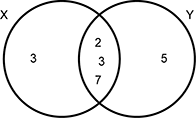 The numbers 2, 3, and 7 are in the overlapping area, the number 3 is in the non-overlapping area of the circle labeled X, and the number 5 is in the non-overlapping area of the circle labeled Y.
The numbers 2, 3, and 7 are in the overlapping area, the number 3 is in the non-overlapping area of the circle labeled X, and the number 5 is in the non-overlapping area of the circle labeled Y.
-
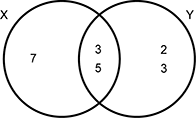 The numbers 3 and 5 are in the overlapping area, the number 7 is in the non-overlapping area of the circle labeled X, and the numbers 2 and 3 are in the non-overlapping area of the circle labeled Y.
The numbers 3 and 5 are in the overlapping area, the number 7 is in the non-overlapping area of the circle labeled X, and the numbers 2 and 3 are in the non-overlapping area of the circle labeled Y.
-
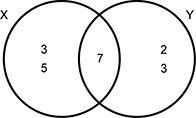 The number 7 is in the overlapping area, the numbers 3 and 5 are in the non-overlapping area of the circle labeled X, and the numbers 2 and 3 are in the non-overlapping area of the circle labeled Y.
The number 7 is in the overlapping area, the numbers 3 and 5 are in the non-overlapping area of the circle labeled X, and the numbers 2 and 3 are in the non-overlapping area of the circle labeled Y.
-
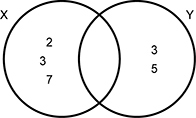 There are no numbers in the overlapping area, the numbers 7, 3, and 2 are in the non-overlapping area of the circle labeled X, and the numbers 3 and 5 are in the non-overlapping area of the circle labeled Y.
There are no numbers in the overlapping area, the numbers 7, 3, and 2 are in the non-overlapping area of the circle labeled X, and the numbers 3 and 5 are in the non-overlapping area of the circle labeled Y.
Answer to question 4
- Answer Enter to expand or collapse answer. Answer expanded
- Correct Response: B. (Objective 0010) The numbers contained in circle X of the Venn diagram represent the prime factorization of X. Similarly, the numbers contained in circle Y represent the prime factorization of Y. All the numbers in both circles collectively represent the prime factorization of the least common multiple of X and Y, and the numbers in the intersection of the circles represent the prime factorization of the greatest common factor of X and Y. The prime factorization of 630 is 2 •times 3 •times 3 •times 5 •times 7, and the prime factorization of 15 is 3 •times 5. When 3 and 5 are placed in the intersection of the circles, the factors in the prime factorization of 630 not yet accounted for are 2, 3, and 7. Because the actual values of X and Y are unknown, it does not matter in which circle these three numbers are placed, as long as they are not placed in the intersecting region of the circles. The Venn diagram that best displays the prime factorization of X and Y is response B.
Question 5
5. What is the multiplicative inverse of 0.2?
- – negative 5
- – negative 0.2
- 2.0
- 5
Answer to question 5
- Answer Enter to expand or collapse answer. Answer expanded
- Correct Response: D. (Objective 0010) The multiplicative inverse, or reciprocal, of a number is the value which when multiplied by that number will result in 1, the multiplicative identity. The fraction equivalent of 0.2 is
 and the reciprocal of
and the reciprocal of
 is 5. 5 × times
is 5. 5 × times
 = 1. The multiplicative inverse of 0.2 is 5.
= 1. The multiplicative inverse of 0.2 is 5.
Question 6
6. Use the diagram below to answer the question that follows.
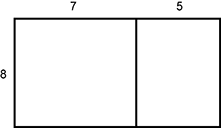
The area diagram shown can be used to model which of the following expressions?
- 8 •times 7 + 5
- 7 + 5 •times 8
- 8 + (7 •times 5)
- (7 + 5) •times 8
Answer to question 6
- Answer Enter to expand or collapse answer. Answer expanded
- Correct Response: D. (Objective 0010) The diagram shown is a rectangle with width 8 units and length separated into two parts, one part 7 units and the other part 5 units. To find the area of the entire rectangle multiply the width by the length; that is, multiply 8 by the sum of the two sections of length, 7 + 5. Since the summing 7 + 5 must be done before the multiplying by 8, the sum must be in parentheses. The expression (7 + 5) •times 8 best models the area of the rectangle.
Question 7
7. Use the pattern below to answer the question that follows.

Position one: one row containing two dots Position two: two rows, each containing two dots Position three: two rows, each containing three dots Position four: three rows, each containing three dots Position five: three rows, each containing four dots Position six: four rows, each containing four dots Position seven: four rows, each containing five dots A set of ellipses Position 11: a blank containing a question mark
If the pattern shown continues, how many dots will be in the figure at position 11?
- 30
- 36
- 42
- 48
Answer to question 7
- Answer Enter to expand or collapse answer. Answer expanded
- Correct Response: C. (Objective 0011) In each successive figure, either one row or one column of dots is added to the previous figure. Count the number of dots per row and column in each figure, as shown in the table below:
| blank |
Figure Position
|
|
1
|
2
|
3
|
4
|
5
|
6
|
7
|
Number of dots
per row
|
2 |
2 |
3 |
3 |
4 |
4 |
5 |
Number of dots
per column
|
1 |
2 |
2 |
3 |
3 |
4 |
4 |
Question 8
8. Use the graph below to answer the question that follows.
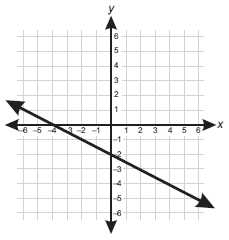
Starting in the second quadrant and decreasing passing the x axis at open parenthesis negative four comma zero close parenthesis into the third quadrant crossing the y axis at open parenthesis zero comma negative two close parenthesis continuing to decrease into the fourth quadrant
What is the slope of the line in the graph shown?
- 4
-

-

- –negative 2
Answer to question 8
- Answer Enter to expand or collapse answer. Answer expanded
- Correct Response: C. (Objective 0011) To find the slope, choose two points on the line, such as (– negative 4, 0) and (0, –negative 2). The slope is m =
 , where Δy represents the change between the y coordinates of the two points, and Δx represents the change between the x coordinates of the two points. Thus, m =
, where Δy represents the change between the y coordinates of the two points, and Δx represents the change between the x coordinates of the two points. Thus, m =
 .
.
Question 9
9. Which of the following values of t solves the equation
 for t?
for t?
-
 t equals 1 over 18
t equals 1 over 18
-
 t equals 7 over 36
t equals 7 over 36
-
 t equals 1 third
t equals 1 third
-
 t equals 7 over 6
t equals 7 over 6
Answer to question 9
- Answer Enter to expand or collapse answer. Answer expanded
- Correct Response: C. (Objective 0011) Multiply all the terms on both sides of the equation by the least common multiple of the denominators 3, 4, 6, and 12 and solve the resulting equation. Thus,
 twelve open parenthesis five twelfths plus seven sixths t close parenthesis equals twelve open parenthesis five sixths t plus three fourths minus two thirds t close parenthesis leads to five plus fourteen t equals ten t plus nine minus eight t leads to twelve t equals fours leads to t equals one third.
twelve open parenthesis five twelfths plus seven sixths t close parenthesis equals twelve open parenthesis five sixths t plus three fourths minus two thirds t close parenthesis leads to five plus fourteen t equals ten t plus nine minus eight t leads to twelve t equals fours leads to t equals one third.
Question 10
10. Use the diagram below to answer the question that follows.

The first rectangle is a 2 by 4 grid with 1 shaded region. The second rectangle is a 4 by 6 grid with 7 shaded regions. The third rectangle is a 4 by 6 grid with 11 shaded regions. The fourth rectangle is a 2 by 4 grid with 5 shaded regions.
If the pattern in this sequence continues, which of the following diagrams could come next?
-

-

-

-

Answer to question 10
- Answer Enter to expand or collapse answer. Answer expanded
- Correct Response: A. (Objective 0011) The diagram models the sequence of fractions
 ,
,
 ,
,
 ,
,
 , ... . Converting all the fractions so they have common denominators results in the sequence
, ... . Converting all the fractions so they have common denominators results in the sequence
 ,
,
 ,
,
 ,
,
 , ... , which has a pattern of adding
, ... , which has a pattern of adding
 to each term to get the next term. The next diagram should model the fraction
to each term to get the next term. The next diagram should model the fraction
 The diagram models the sequence of fractions 1 eighth, 7 twenty fourths, 11 twenty fourths, 5 eighths,…. Converting all the fractions so they have common denominators results in the sequence 3 twenty fourths, 7 twenty fourths, 11 twenty fourths, 15 twenty fourths…, which has a pattern of adding 4 twenty fourths to each term to get the next term. The next diagram should model the fraction 19 twenty fourths..
The diagram models the sequence of fractions 1 eighth, 7 twenty fourths, 11 twenty fourths, 5 eighths,…. Converting all the fractions so they have common denominators results in the sequence 3 twenty fourths, 7 twenty fourths, 11 twenty fourths, 15 twenty fourths…, which has a pattern of adding 4 twenty fourths to each term to get the next term. The next diagram should model the fraction 19 twenty fourths..
Question 11
11. Use the diagram below to answer the question that follows.

From left to right, the first arrow contains the expression plus 3, the second arrow contains times 2, and the third arrow contains minus 1.
Which of the following graphs best represents the inputs and outputs produced by the function machine shown?
-
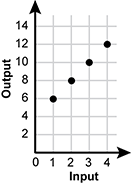 The x axis is labeled input and is marked with evenly spaced increments as 1, 2, 3, and 4. The y axis is labeled output and is marked with evenly spaced increments as 2, 4, 6, 8, 10, 12, 14. Points are drawn at 1 comma 6, 2 comma 8, 3 comma 10, and 4 comma 12.
The x axis is labeled input and is marked with evenly spaced increments as 1, 2, 3, and 4. The y axis is labeled output and is marked with evenly spaced increments as 2, 4, 6, 8, 10, 12, 14. Points are drawn at 1 comma 6, 2 comma 8, 3 comma 10, and 4 comma 12.
-
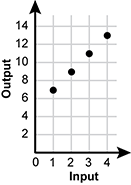 The x axis is labeled input and is marked with evenly spaced increments as 1, 2, 3, and 4. The y axis is labeled output and is marked with evenly spaced increments as 2, 4, 6, 8, 10, 12, 14. Points are drawn at 1 comma 7, 2 comma 9, 3 comma 11, and 4 comma 13.
The x axis is labeled input and is marked with evenly spaced increments as 1, 2, 3, and 4. The y axis is labeled output and is marked with evenly spaced increments as 2, 4, 6, 8, 10, 12, 14. Points are drawn at 1 comma 7, 2 comma 9, 3 comma 11, and 4 comma 13.
-
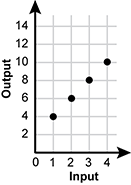 The x axis is labeled input and is marked with evenly spaced increments as 1, 2, 3, and 4. The y axis is labeled output and is marked with evenly spaced increments as 2, 4, 6, 8, 10, 12, 14. Points are drawn at 1 comma 4, 2 comma 6, 3 comma 8, and 4 comma 10.
The x axis is labeled input and is marked with evenly spaced increments as 1, 2, 3, and 4. The y axis is labeled output and is marked with evenly spaced increments as 2, 4, 6, 8, 10, 12, 14. Points are drawn at 1 comma 4, 2 comma 6, 3 comma 8, and 4 comma 10.
-
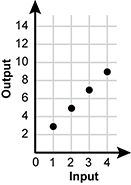 The x axis is labeled input and is marked with evenly spaced increments as 1, 2, 3, and 4. The y axis is labeled output and is marked with evenly spaced increments as 2, 4, 6, 8, 10, 12, 14. Points are drawn at 1 comma 3, 2 comma 5, 3 comma 7, and 4 comma 9.
The x axis is labeled input and is marked with evenly spaced increments as 1, 2, 3, and 4. The y axis is labeled output and is marked with evenly spaced increments as 2, 4, 6, 8, 10, 12, 14. Points are drawn at 1 comma 3, 2 comma 5, 3 comma 7, and 4 comma 9.
Answer to question 11
- Answer Enter to expand or collapse answer. Answer expanded
- Correct Response: B. (Objective 0011) A function machine is a diagram that takes an input, applies a sequence of rules, and then produces an output. In this particular function machine, each input adds 3, then multiplies that result by 2, and lastly subtracts 1 from that product. The input of 1 produces output of 7 as follows: 1 + 3 = 4, 4 ×times 2 = 8, 8 −minus 1 = 7. Likewise, input of 2 produces output of 9, input of 3 produces output of 11, and input of 4 produces output of 13. The graph showing the ordered pairs corresponding to these inputs and outputs is the graph in response B.
Question 12
12. Use the diagram below to answer the question that follows.
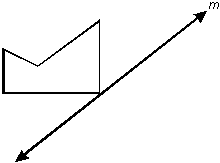
The polygon is composed of 5 line segments that are oriented as follows: A B is vertical on the right side, B C is horizontal on the bottom, C D is vertical on the left side. The top of the polygon, line segment D E slopes down to the right and line segment E A slopes up to the right forming a v-shaped notch. Line m, a forty-five degree line, touches the polygon at Point B. Polygon A B C D E, using dotted line segments, is drawn again below and to the right of line m. The polygon is oriented with the line segments as follows: D C is horizontal at the bottom, C B is vertical on the left side, and B A is horizontal on the top. Point B touches line m.
Which of the following figures represents a reflection over line m of the figure shown in the diagram?
-

-

-

-

Answer to question 12
- Answer Enter to expand or collapse answer. Answer expanded
- Correct Response: A. (Objective 0012) A reflection flips a figure over a line, keeping the image congruent to the original shape. The original figure has one vertex on reflection line m. Because line m forms approximately a 45° degrees angle with the horizontal, flipping the given figure over line m is equivalent to flipping the original figure horizontally and then rotating it 90° degrees clockwise around the vertex that lies on line m. The diagram below shows the original shape using solid line segments and its reflection over line m using dotted line segments. The shape in response A shows the correct orientation of the original shape after the reflection.
Question 13
13. Use the diagram below to answer the question that follows.
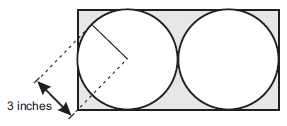
In the diagram shown, two identical circles are inscribed within a rectangle. Which of the following expressions represents the area of the shaded portion of the diagram?
- 72 −minus 18π pi
- 72 −minus 12π pi
- 36 −minus 9π pi
- 36 −minus 6π pi
Answer to question 13
- Answer Enter to expand or collapse answer. Answer expanded
- Correct Response: A. (Objective 0012) The area of the shaded portion is the difference between the area of the rectangle and the area of the two circles. The radius of a circle is 3 inches and the area of each circle is πr2 pi r squared, or 9π pi. Thus, the length of the rectangle is 4 ×times 3, or 12 inches, and the width of the rectangle is 2 ×times 3, or 6 inches. The area of the rectangle is 6 ×times 12, or 72 inches. Therefore, the area of the shaded portion is 72 −minus 2(9π pi), or 72 −minus 18π pi.
Question 14
14. The diagonals of quadrilateral ABCD bisect the interior angles of ABCDand intersect at 90° degree angles. Which of the following polygons best represents quadrilateral ABCD?
-

-

-

-

Answer to question 14
- Answer Enter to expand or collapse answer. Answer expanded
- Correct Response: A. (Objective 0012) Quadrilateral ABCD must be a rhombus if the diagonals both bisect the interior angles and intersect at a 90° degree angle. The shape shown in response A has four congruent sides and is a rhombus.
Question 15
15. Use the diagram below to answer the question that follows.
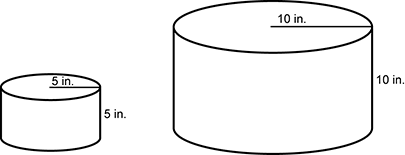
The smaller cylinder has a base with radius of 5 inches and a height of 5 inches. The larger cylinder has a base with radius of 10 inches and a height of 10 inches.
The smaller cylinder in the diagram shown is filled completely with water; then the water is poured into the larger cylinder. What is the height of the water in the larger cylinder?
- 1.25 inches
- 2 inches
- 2.5 inches
- 5 inches
Answer to question 15
- Answer Enter to expand or collapse answer. Answer expanded
- Correct Response: A. (Objective 0012) The volume of a cylinder is found using the formula V = πr2h pi r squared h, where r represents the radius of the base and h represents the height of the cylinder. The volume of the smaller cylinder is π • 52 • 5 = 125π pi times 5 squared times 5, which equals 125 pi cubic inches. To find the height of the water after it is poured into the larger cylinder, substitute known values into the volume formula and solve for h. That is, 125π = π • 102 • h125 pi equals pi times 10 squared times h, , which is equivalent to 125π = 100πh125 pi, which equals 100 pi h. Solving for h yields that the height of the water in the larger cylinder is
 = 1.25 inches.
= 1.25 inches.
Question 16
16. A cardboard box measures 2 feet long, 12 inches wide, and 6 inches tall. What is the length, to the nearest tenth of an inch, of the longest diagonal of the box?
- 12.2 inches
- 13.6 inches
- 26.8 inches
- 27.5 inches
Answer to question 16
- Answer Enter to expand or collapse answer. Answer expanded
- Correct Response: D. (Objective 0012) To find the diagonal of the box, first convert all the dimensions to inches to obtain the dimensions L = 24 inches, W = 12 inches, and H = 6 inches. Then use the Pythagorean theorem twice: once using the length, L, and width, W, of the box to find the diagonal of the base of the box, B, and then again using the diagonal of the base of the box, B, with the height of the box, H, to find the diagonal of the box, D. The diagonal of the base of the box, B, can be found by solving L2 + W2 = B2 for B; that is, 242 + 122 = 720 = B2, so B =
 L squared plus W squared equals B squared for B; that is, 24 squared plus 12 squared, which equals 720, which equals B squared, so B equals the square root of 720. The diagonal of the box, D, can be found by solving B2 + H2 = D2 for D; that is,
L squared plus W squared equals B squared for B; that is, 24 squared plus 12 squared, which equals 720, which equals B squared, so B equals the square root of 720. The diagonal of the box, D, can be found by solving B2 + H2 = D2 for D; that is,
 + 62 = 756 = D2, so D ≈ 27.5 inchesB squared plus H squared equals D squared for D; that is, the square root of 720 squared plus 6 squared, which equals 756, which equals D squared, so D is approximately equal to 27.5 inches.
+ 62 = 756 = D2, so D ≈ 27.5 inchesB squared plus H squared equals D squared for D; that is, the square root of 720 squared plus 6 squared, which equals 756, which equals D squared, so D is approximately equal to 27.5 inches.
Question 17
17. Use the table below to answer the question that follows.
|
Type of Soda
|
Number of Cans
|
| Cola |
26 |
| Ginger Ale |
16 |
| Orange Soda |
10 |
| Root Beer |
8 |
The table shows the type and number of sodas in a vending machine. If a can of soda is chosen randomly, which of the following decimals represents the probability that the soda will be either ginger ale or root beer?
- 0.15
- 0.24
- 0.40
- 0.52
Answer to question 17
- Answer Enter to expand or collapse answer. Answer expanded
- Correct Response: C. (Objective 0013) The total number of cans is 60. The number of cans of ginger ale and root beer combined is 24. The probability of randomly selecting a can of ginger ale or root beer from the total number of cans available is
 = 0.40.
= 0.40.
Question 18
18. Use the graph below to answer the question that follows.
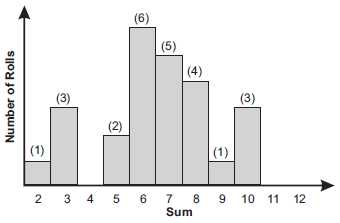
The faces of a pair of number cubes are labeled with the numerals 1– to 6. The number cubes are rolled 25 times and the sum of each roll is shown in the graph above. Which of the following statements is supported by the graph?
- Seventy-five percent of the rolls produced sums that were even.
- The sum of 7 was rolled most frequently.
- Two-fifths of the rolls produced sums that were more than 8.
- A sum of 9 or 10 was rolled as often as a sum of less than 4.
Answer to question 18
- Answer Enter to expand or collapse answer. Answer expanded
- Correct Response: D. (Objective 0013) Based on the information presented in the graph, a sum of 9 or 10 was rolled 4 times (1 + 3). A sum of less than 4 is the combined number of times that a 2 or a 3 was rolled (1 + 3). Thus, a sum of 9 or 10 was rolled as often as a sum of less than 4.
Question 19
19. Use the table below to answer the question that follows.
|
Day
|
1 |
2 |
3 |
4 |
|
Miles driven
|
264 |
420 |
? |
273 |
|
Gallons of gas used
|
11 |
15 |
12 |
9 |
A family took a road trip and intended to record the miles driven and the number of gallons of gas used every day in the table below. However, the family forgot to record the miles driven on the third day of the trip. If the mean of the gas usage for the entire trip was 27 miles per gallon, how many miles were driven on day 3?
- 298
- 312
- 324
- 346
Answer to question 19
- Answer Enter to expand or collapse answer. Answer expanded
- Correct Response: B. (Objective 0013) The mean number of miles per gallon is equal to the sum of all the miles driven divided by the sum of all the gallons used. Therefore, the situation can be represented by the equation 27 =
 , which is equivalent to the equation 27 =
, which is equivalent to the equation 27 =
 . Solve the equation for x to find the number of miles driven on day 3: (47)27 =
. Solve the equation for x to find the number of miles driven on day 3: (47)27 =
 (47), which simplifies to 1,269 = 957 + x, so x = 312 miles.The mean number of miles per gallon is equal to the sum of all the miles driven divided by the sum of all the gallons used. Therefore, the situation can be represented by the equation 27 equals the quantity 265 plus 420 plus x plus 273 over the quantity 11 plus 15 plus 12 plus 9, which is equivalent to the equation 27 equals the quantity 957 plus x over 47. Solve the equation for x to find the number of miles driven on day 3: 47 times 27 equals the quantity 957 plus x over 47, all multiplied by 47, which simplifies to 1,269 equals 957 plus x, so x equals 312 miles.
(47), which simplifies to 1,269 = 957 + x, so x = 312 miles.The mean number of miles per gallon is equal to the sum of all the miles driven divided by the sum of all the gallons used. Therefore, the situation can be represented by the equation 27 equals the quantity 265 plus 420 plus x plus 273 over the quantity 11 plus 15 plus 12 plus 9, which is equivalent to the equation 27 equals the quantity 957 plus x over 47. Solve the equation for x to find the number of miles driven on day 3: 47 times 27 equals the quantity 957 plus x over 47, all multiplied by 47, which simplifies to 1,269 equals 957 plus x, so x equals 312 miles.
Question 20
20. Use the table below to answer the question that follows.
|
Height of plant
|
Number of plants
|
| 21– to 30 cm |
5 |
| 31– to 40 cm |
8 |
| 41– to 50 cm |
6 |
| 51– to 60 cm |
3 |
| 61– to 70 cm |
1 |
Students measured the heights of seedlings after one month and recorded the results in the table shown. Which of the following types of graphs would best display these data?
- box and whiskers plot
- histogram
- segmented bar chart
- scatterplot
Answer to question 20
- Answer Enter to expand or collapse answer. Answer expanded
- Correct Response: B. (Objective 0013) When data is organized into intervals, a histogram is generally the best type of graph for displaying the data. For these data, the horizontal axis of a histogram would display the height intervals and the vertical axis would display the frequencies. The bar heights show how many data points are within each interval.
Question 21
21. Use the information below to answer the question that follows.
Test scores:
86 88 77 60 72 90 71 88 88
Box and whiskers plot:

The number line is labeled test scores and has 16 evenly distributed tick marks with the first tick mark labeled 60, the sixth tick mark labeled 70, the eleventh tick mark labeled 80, and the sixteenth tick mark labeled 90. A box and whiskers plot is shown above the number line. The left-most whisker starts at 60 and extends to the left-most vertical line of the box at 72. Inside the box is a vertical line at 86. The right-most vertical line is at 88, from which extends the right-most whisker to 90.
A student collects data on test scores and creates the corresponding box and whiskers plot, as shown. What is the median of these data?
- 72
- 75
- 80
- 86
Answer to question 21
- Answer Enter to expand or collapse answer. Answer expanded
- Correct Response: D. (Objective 0013) The median of a data set is the middle-most value when the data is arranged numerically. A box and whiskers plot displays the median as the value that corresponds to the line that divides the box into two parts; this value in the box and whiskers plot is 86, so the median of these data is 86.
Question 22
22. Use the sequence below to answer the question that follows.
2, 7, 22, 67, …ellipses
In the sequence shown, the nth term, sn , can be represented by which of the following expressions? In the sequence shown, the nth term, s subscript n, can be represented by which of the following expressions?
- 3sn – 1 + 1
- 4sn – 1 – 1
- (sn – 1)2 + 3(n – 1)
- (sn – 1)3 – sn
- 3 s sub quantity open paren n minus 1 close paren plus 1
- 4 s sub quantity open paren n minus 1 close paren minus 1
- open paren s sub quantity open paren n minus 1 close paren close paren the quantity squared plus 3 times the quantity open paren n minus 1 close paren
- open paren s sub quantity open paren n minus 1 close paren close paren the quantity cubed minus s sub n
Answer to question 22
- Answer Enter to expand or collapse answer. Answer expanded
- Correct Response: A. (Objective 0014) Sequence terms can be defined by recursive formulas, which give the value of any term based on the value of the previous term. The symbol sn represents the nth term and the symbol sn − 1subscript n minus 1 represents the term before the nth term. When the difference between terms of a sequence increases by a factor of k, each successive term can be found by multiplying the previous term by k and then adding or subtracting a constant. In this sequence, the difference between 2 and 7 is 5, between 7 and 22 is 15, and between 22 and 67 is 45. The differences increase by a factor of 3. Multiplying each of the first three terms by 3 yields the values 6, 21, and 66, which are all 1 away from the values in the given sequence. The recursive rule to get the nth term is to multiply the previous term by 3 and then add 1, which is represented by the expression 3sn − 1subscript n minus 1 + 1.
Question 23
23. Use the sets below to answer the question that follows.
X = {1, 2, 3, 4, 5}
Y = {3, 6, 9}
Z = {1, 3, 5, 9}
Which of the following Venn diagrams represents the sets X, Y, and Z shown?
-
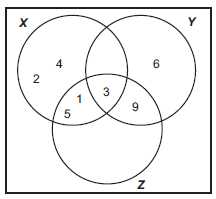
-
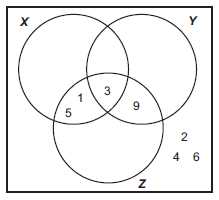
-
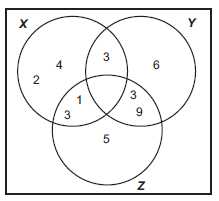
-
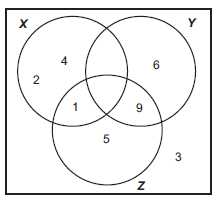
Answer to question 23
- Answer Enter to expand or collapse answer. Answer expanded
- Correct Response: A. (Objective 0014) To solve this problem, identify the numbers that are common to each set. Sets X, Y, and Z have the number 3 in common, represented by the 3 in the portion of the diagram where all three circles overlap. Sets X and Z have 1 and 5 in common, represented by the 1 and 5 in the left overlapping area; sets Y and Z have 9 in common, represented by the 9 in the right overlapping area. X is the only set that contains 2 and 4, and Y is the only set that contains 6.
Question 24
24. Twelve people apply for 4 different jobs. If all of the 12 applicants are equally qualified to fill any of the 4 jobs, which of the following expressions can be used to represent the number of different ways the jobs can be filled?
-
 twleve times 4
twleve times 4
-
 the quantity 12 times 11 times 10 times 9 over the quantity 8 times 7 times 6 times 5
the quantity 12 times 11 times 10 times 9 over the quantity 8 times 7 times 6 times 5
-
 12 times 11 times 10 times 9
12 times 11 times 10 times 9
-
 the quantity 12 times 11 times 10 times 9 over the quantity 4 times 3 times 2 times 1
the quantity 12 times 11 times 10 times 9 over the quantity 4 times 3 times 2 times 1
Answer to question 24
- Answer Enter to expand or collapse answer. Answer expanded
- Correct Response: C. (Objective 0014) This problem is an example of a permutation since placing persons A and B in positions 1 and 2 is not the same as placing persons B and A in those positions. Thus, there are 12 possibilities to fill the first job, 11 to fill the second, and so on. Since there are 4 different jobs, the number of different ways can be found by
 expression 12 times 11 times 10 times 9.
expression 12 times 11 times 10 times 9.
Question 25
25. Use the Venn diagram below to answer the question that follows.
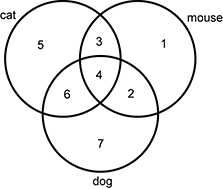
One circle is labeled cat, one is labeled mouse, and one is labeled dog. The region where all three circles overlap contains the number 4. The overlapping region of the circles labeled cat and mouse that does not share area with the circle labeled dog contains the number 3. The overlapping region of the circles labeled mouse and dog that does not share area with the circle labeled cat contains the number 2. The overlapping region of the circles labeled cat and dog that does not share area with the circle labeled mouse contains the number 6. The region of the circle labeled cat that does not share area with the circles labeled mouse or dog contains the number 5. The region of the circle labeled mouse that does not share area with the circles labeled cat or dog contains the number 1. The region of the circle labeled dog that does not share area with the circles labeled mouse or cat contains the number 7.
Students were asked what kind of pet they owned, and the results were summarized in the Venn diagram shown. According to the diagram, how many students own exactly 1 type of pet?
- 11
- 13
- 15
- 17
Answer to question 25
- Answer Enter to expand or collapse answer. Answer expanded
- Correct Response: B. (Objective 0014) The regions of the circles that do not overlap other circles contain the numbers of students who own only 1 type of pet. Five students own only a cat, 1 student owns only a mouse, and 7 students own only a dog, so 5 + 1 + 7 = 13 students own only one type of pet.
Question 26
26. What is the sum of the first 5 terms of an arithmetic sequence that has a 4thfourth term of 35 and an 11theleventh term of 77?
- 115
- 120
- 140
- 145
Answer to question 26
- Answer Enter to expand or collapse answer. Answer expanded
- Correct Response: D. (Objective 0014) The difference between consecutive terms of an arithmetic sequence is constant and is called the common difference. To get from the 4thfourth term to the 11theleventh term, the common difference, d , must be added to the 4thfourth term 7 times. That is, the 4thfourth term is 35 and adding the common difference 7 times will result in the 11theleventh term, 77; this yields the equation 35 + 7d = 77. Solving the equation for d obtains 7d = 77 −minus 35 = 42, so d = 6. Working backwards from the 4thfourth term of 35, the 3rdthird term is 29, the 2ndsecond term is 23, and the 1stfirst term is 17. Working forwards from the 4thfourth term of 35, the 5th term is 35 + 6 = 41. The sum of the first 5 terms is 17 + 23 + 29 + 35 + 41 = 145.
Question 27
27. Use the diagram below to answer the question that follows.
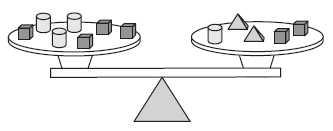
On the left side are 4 cubes and 3 cylinders. On the right side there is a cylinder, 2 pyramids, and 2 cubes
If the scale shown is balanced, which of the following expressions represents a valid conclusion that can be drawn from the diagram?
-

-

-

-

Answer to question 27
- Answer Enter to expand or collapse answer. Answer expanded
- Correct Response: B. (Objective 0015) Solve this problem using deductive reasoning. Let c represent the number of cubes, b represent the number of barrels, and p represent the number of pyramids. Since the scale is balanced, 4 c + 3 b = 1 b + 2 p + 2 c. Grouping the variables results in (4 c −minus 2 c) + (3 b −minus 1 b) = 2 p, or 2 c + 2 b = 2 p. This is equivalent to p = c + b.
Question 28
28. The development of computer models that are used in weather forecasting relies most heavily on which of the following branches of mathematics to predict weather outcomes?
- trigonometry
- geometry
- number theory
- statistics
Answer to question 28
- Answer Enter to expand or collapse answer. Answer expanded
- Correct Response: D. (Objective 0015) The computer models used in weather forecasting are dependent on the analysis of numerical data, such as temperature and wind speed, for making accurate predictions. This is an essential part of the field of statistics.
Question 29
29. A particular function rule states that, for some input n, double the input, subtract 4, and then add n. Which of the following ordered pairs could result from the application of this function rule?
- (1, – negative 2)
- (2, 10)
- (3, 5)
- (4, – negative 8)
Answer to question 29
- Answer Enter to expand or collapse answer. Answer expanded
- Correct Response: C. (Objective 0015) By the function rule, the input, n, must be doubled, hence f(n) = 2n. Then "subtract 4" means f(n) = 2n − 4. Finally, "add n" means f(n) = 2n − 4 + n = 3n − 4. Consider that f(3) = 3(3) − 4 = 5. The only ordered pair that satisfies the function rule is (3, 5). By the function rule, the input, n, must be doubled, hence f of n equals 2 n. Then "subtract 4" means f of n equals 2 n minus 4. Finally, "add n" means f of n equals 2 n minus 4 plus n, which equals 3 n minus 4. Consider that f of 3 equals 3 times 3 minus 4, which equals 5. The only ordered pair that satisfies the function rule is the points 3 comma 5.
Question 30
30. Use the problem below to answer the question that follows.
After cashing a paycheck, a lab technician paid a phone bill and then spent
 of what remained on rent. Next, the lab technician bought $7575 dollars worth of groceries and put
of what remained on rent. Next, the lab technician bought $7575 dollars worth of groceries and put
 of what remained into a savings account, leaving $2424 dollars from the original paycheck. How much money was in the original paycheck?
of what remained into a savings account, leaving $2424 dollars from the original paycheck. How much money was in the original paycheck?
Which of the following problem-solving strategies is likely to be most efficient when solving the problem shown?
- working backwards
- using manipulatives
- guessing and checking
- finding a pattern
Answer to question 30
- Answer Enter to expand or collapse answer. Answer expanded
- Correct Response: A. (Objective 0015) To solve this problem, start at the end of the problem with $2424 dollars and use inverse operations to get to the unknown amount at the beginning of the problem. Working backwards would be the best method for solving the given problem.
Question 31
31. Children's diets should include adequate amounts of vitamin D and calcium because of the essential role these nutrients play in:
- activating the immune system to produce antibodies.
- reducing cholesterol levels in the blood.
- helping cells use oxygen to release energy from food.
- building and maintaining strong bones.
Answer to question 31
- Answer Enter to expand or collapse answer. Answer expanded
- Correct Response: D. (Objective 0016) An adequate intake of vitamin D and calcium is essential for children's bone health and growth. Vitamin D, a fat-soluble vitamin, and calcium, a mineral, work together to enable mineral deposition into bones, thereby increasing bone density and strength.
Question 32
32. In the context of discussing the artistic elements of a painting, the term value would refer to the:
- predominance of cool or warm colors in the painting.
- lightness or darkness of colors used in the painting.
- degree of realism resulting from the artistic style of the painting.
- overall balance in the composition of the painting.
Answer to question 32
- Answer Enter to expand or collapse answer. Answer expanded
- Correct Response: B. (Objective 0017) The term value as used in painting most often refers to the change in color tone from light to dark or from white to black.
Question 33
33. The lessons in an elementary-level health and wellness unit are designed to promote and build on health-related protective factors such as maintaining a positive self-image and outlook on life; having good communication, problem-solving, decision-making, and social skills; expressing and managing emotions appropriately; and belonging to supportive family and school community groups. The goal of this unit is most likely to help students:
- develop a deeper understanding of the citizenship traits and skills valued in a democratic society.
- replace sad or negative thoughts with constructive ones about ways to change personal circumstances.
- develop resiliency, the ability to adapt to change and overcome and recover from hardships.
- minimize their personal exposure to difficult conditions in neighborhoods and communities.
Answer to question 33
- Answer Enter to expand or collapse answer. Answer expanded
- Correct Response: C. (Objective 0016) Resiliency, which enables children to cope in healthy ways to adversity, tragedy, and other significant stressors, as well as persevere and recover following traumatic events, develops as a result of a combination of protective factors. Self-efficacy, the ability to self-regulate and control emotions and behaviors; supportive relationships with adults at home and at school; and coping and stress-management skills are just some of the factors that predispose children to positive outcomes in the face of hardship. Teachers can support this development by promoting students' self-confidence, building school-family connections, helping to create a sense of security for students, and helping students strengthen their adaptive skills and self-regulatory capacities.
Question 34
34. During a fifth-grade health lesson, students learn about and generate a list of effects of lifestyle risks on dimensions of health and wellness. A partial list of the negative effects of one lifestyle behavior is shown below.
Cognitive Effects:
- interferes with the brain's communication pathways
-
inhibits reasoning, judgment, and memory
Physical Effects:
- decreases motor coordination and balance
- causes high blood pressure
- leads to liver damage
Social/Emotional Effects:
- damages relationships
- impairs ability to study and work
This list is most closely aligned with health consequences of which of the following lifestyle risks?
- binge drinking alcohol
- habitually smoking cigarettes
- using prescription stimulants recreationally
- using anabolic steroids without a prescription
Answer to question 34
- Answer Enter to expand or collapse answer. Answer expanded
- Correct Response: A. (Objective 0016) Alcohol is a depressant that reduces activity in the central nervous system, which affects motor coordination, balance, and reaction time. In the brain, alcohol can slow the rate of communication between neurotransmitters. Alcohol use is associated with confused thinking, impaired decision making, and short-term attention and memory problems. Physiological long-term effects of binge drinking or heavy alcohol use include stress on the heart, high blood pressure, fat buildup in the liver, and a weakened immune system. Excessive alcohol use is also associated with interpersonal and family issues and conflicts, social phobias, and job difficulties and losses.
Question 35
35. Which of the following physical activities would be most developmentally appropriate for promoting the fundamental object-control skills of kindergarten students?
- practicing hopping on one foot across the length of a room
- tossing a ball in the air and striking it with a plastic bat toward a fence
- traveling through an obstacle course while avoiding and jumping over objects
- playing keep-it-up with beach balls using short-handled paddles
Answer to question 35
- Answer Enter to expand or collapse answer. Answer expanded
- Correct Response: D. (Objective 0016) Object-control or manipulative skills are motor skills that require students to move and control an object using an implement or a part of the body such as the hands or feet. Playing keep-it-up is a suitable activity for the motor development level of kindergartners and requires use of the object-control skill of striking, in this case manipulating a short-handled paddle to strike and control a beach ball. The fundamental object-control skill of striking is a foundational movement underlying more complex motor skills such as those used in ping pong, volleyball, badminton, tennis, and softball.
Question 36
36. Fifth-grade students are participating in a four-week wellness project. Students have created individualized physical activity plans that include a cardiorespiratory activity they will do, how often they will participate in the activity, how long each activity session will last, and the target heart rate zone they wish to achieve during the activity session. For example, one student has decided to cycle three days a week for 40 minutes per session, with a goal of attaining a target heart rate of 70– to 80 percent of maximum heart rate while cycling. Students will use journals to record their progress in meeting their initial goals. This wellness project is likely to be most effective for increasing students' understanding of:
- how to promote strength and build muscle mass using anaerobic exercise.
- the distinctions between the skill-related fitness attributes of agility, coordination, power, reaction time, and speed.
- how to use the FITT (frequency, intensity, type, time) exercise training principle.
- the components of health-related fitness (e.g., cardiorespiratory endurance, muscular strength , flexibility, body composition).
Answer to question 36
- Answer Enter to expand or collapse answer. Answer expanded
- Correct Response: C. (Objective 0016) Creating an individualized physical activity plan according to the four components of the FITT principle helps students systematically achieve health-related fitness benefits. Frequency is how often a person performs the chosen physical activity. Intensity is how hard a person exercises during a physical activity period. During cardiorespiratory activity, intensity is usually measured by heart rate. Time refers to the duration of the physical activity. Type refers to the kind of physical activity chosen to improve a component of health-related fitness, in this case cardiorespiratory or aerobic endurance.
Question 37
37. Folk dancing best illustrates the function of dance in many cultures as an expression of:
- community identity.
- concerns about social issues.
- individual creativity.
- universal aesthetic values.
Answer to question 37
- Answer Enter to expand or collapse answer. Answer expanded
- Correct Response: A. (Objective 0017) Folk dancing is a broad term for many types of traditional dancing that serve to express cultural and community identity.
Question 38
38. In theater, actors primarily use improvisation to:
- practice lines they will use during a play.
- create dialogue for the playwright.
- enhance their understanding of a character.
- become comfortable in costume.
Answer to question 38
- Answer Enter to expand or collapse answer. Answer expanded
- Correct Response: C. (Objective 0017) Improvisation is a performance exercise that involves two or more people spontaneously acting out a scene without a script. Improvisation has many uses in theater, including teaching actors about various aspects of acting and enlightening them about their characters. Improvisation can help an actor gain a better understanding of what drives his or her character and a better understanding of how the character might respond in given situations.
Question 39
39. In music, the term harmony refers to:
- a succession of sounds over time.
- the richness or aesthetic quality of sounds.
- the repetition of similar sounds.
- two or more sounds occurring simultaneously.
Answer to question 39
- Answer Enter to expand or collapse answer. Answer expanded
- Correct Response: D. (Objective 0017) Harmony refers to the sound of two or more notes at the same time. Since its notes are played simultaneously, harmony is often described as being vertical, whereas melody—notes played in succession—is considered "horizontal."
Question 40
40. At which of the following ages are children most likely to start drawing representationally?
- 3
- 6
- 9
- 12
Answer to question 40
- Answer Enter to expand or collapse answer. Answer expanded
- Correct Response: B. (Objective 0017) While every person is different and develops in unique ways at differing rates, between the age of 4 and 7 children generally start to move from scribbling to making their first attempts to represent something on the page. Art educator Viktor Lowenfeld called this stage of development the "Preschematic Stage." Typically, the first subject of representational drawing for children is a person, with a circle for a head and vertical lines for legs.